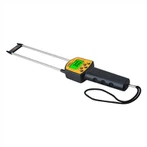Troubleshooting Common Issues with Coating Thickness Gauges
What should I do if the instrument doesn't respond when turned on?
Answer: First, check if the battery is installed upside down; Or consider whether the battery is dead. If it still cannot be turned on after ruling out the battery problem, it is necessary to contact the manufacturer.
2. Normal startup, but no response during testing?
Answer: First, rule out whether the null zero position has been calibrated, and then recalibrate it to operate normally.
Why does the measurement of the workpiece still show "inaccurate" after calibration on the randomly attached calibration test piece?
Answer: There are many factors that affect the measured values, which are described in detail in this manual. The properties of metal materials, surface roughness, etc. all have an impact on the measured values. The randomly attached substrate often differs greatly from the metal substrate on site by the user. Therefore, we recommend that the randomly attached substrate and test piece be used only for instrument calibration. In actual on-site measurement of workpieces, the same material that has not been sprayed on site should be used as the substrate.
Why is it "inaccurate" to measure curved materials such as pipes and bars?
Answer: The curvature change has a significant impact on the coating thickness gauge. If you calibrate the zero point on a flat substrate and directly measure the surface, there will definitely be a deviation in the measured value. The correct operation is to calibrate the zero point on an unpainted workpiece substrate with the same radius of curvature, and then measure the coating thickness. At this time, the measured value is accurate and error free.
How to determine if there is a "deviation" in measuring the coating of the workpiece when the instrument measures the test piece accurately?
Answer: Some users may experience measurement errors on randomly matched substrate test pieces during use, or when measuring the same workpiece with instruments from different manufacturers. In such cases, users often do not know whether it is a problem with their own process or the instrument itself. This problem is easy to solve. We just need to place the randomly matched test piece on the user's own unpainted workpiece substrate and measure it, because the value of the test piece is constant. If the measurement of the test piece on the workpiece is also accurate, it means that there is no problem with the instrument.





